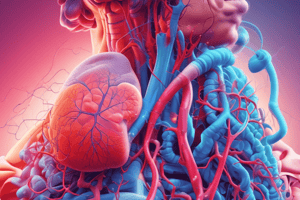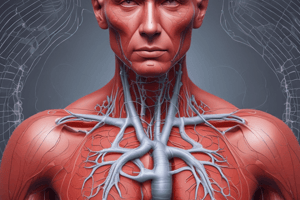Podcast
Questions and Answers
Match
Match
Nasal Cannula = low or high flow: most commonly used, 1-6 Lpm, high flow 30-60 Lpm up to 100% humidified air Simple Mask = low-flow, used when nasal cannula is contraindicated, 5-10 Lpm, don’t set flow rate <5Lpm possible Co2 retention. Nonrebreather = Gives highest concentration of O2 via low flow mask. Valves on the side of mask to prevent breathing in exhaled air, one way valve over reservoir bag prevent exhaled gas to enter bag. Flow rare 10-15, no less than 10Lpm Venturi Mask = High flow fixed performance device, allows mask to deliver most PERCISE concentrations of oxygen. The different barrels control O2 concentrations. Make sure ports on barrels are always open. Flow rate 4-6 Lpm= 24-40%
Suppressants = Codeine, Dextromethorphan Expectorant = Guaifensin Lozenges = Benzocaine Bronchodilator = Albuterol
Corticosteroid = Prednisone, Dexamethasone Antihistamine = fexofenadine, cetirizine, diphenhydramine Leukotriene receptor antagonist = Montelukast Blank = Blank
Normal Breath Sounds
Normal Breath Sounds
Abnormal Breath Sounds
Abnormal Breath Sounds
Administering inhaled medications
Administering inhaled medications
Medications
Medications
Factors Influencing Diffusion of Gases in the Lungs and their examples
Factors Influencing Diffusion of Gases in the Lungs and their examples
Match the following respiratory conditions with their descriptions:
Match the following respiratory conditions with their descriptions:
Match the breathing technique with its purpose:
Match the breathing technique with its purpose:
What is the recommended position for a patient experiencing difficulty breathing?
What is the recommended position for a patient experiencing difficulty breathing?
In patients with COVID and ARDS, which position is suggested to enhance oxygenation?
In patients with COVID and ARDS, which position is suggested to enhance oxygenation?
What is the primary purpose of tracheal suctioning in patients?
What is the primary purpose of tracheal suctioning in patients?
When should humidification be recommended for patients?
When should humidification be recommended for patients?
What is identified as the most common cause of airway obstruction in adults?
What is identified as the most common cause of airway obstruction in adults?
What is the main organ of circulation in the cardiovascular system?
What is the main organ of circulation in the cardiovascular system?
Which condition is characterized by an inadequate amount of oxygen available to the cells?
Which condition is characterized by an inadequate amount of oxygen available to the cells?
What causes the appearance of leaning forward and limits respiratory ventilation in elders?
What causes the appearance of leaning forward and limits respiratory ventilation in elders?
What can stress lead to, that results in low CO2 levels in arterial blood gas (ABG)?
What can stress lead to, that results in low CO2 levels in arterial blood gas (ABG)?
Which factor in older adults makes bony landmarks more prominent?
Which factor in older adults makes bony landmarks more prominent?
Why is it important for patients on CNS-affecting medications to be monitored?
Why is it important for patients on CNS-affecting medications to be monitored?
_________ is carried via red blood cells due to binding between the hemoglobin in RBCs and oxygen
_________ is carried via red blood cells due to binding between the hemoglobin in RBCs and oxygen
What is the potential impact of medications that decrease heart rate on blood flow to body tissues?
What is the potential impact of medications that decrease heart rate on blood flow to body tissues?
What is a common issue associated with stress that can lead to an episode of bronchial asthma?
What is a common issue associated with stress that can lead to an episode of bronchial asthma?
How does barrel chest deformity in older adults affect their chest anatomy?
How does barrel chest deformity in older adults affect their chest anatomy?
What is a common consequence of aging on the diaphragm's efficiency in older adults?
What is a common consequence of aging on the diaphragm's efficiency in older adults?
What effect can incorrect trach suctioning have on patients?
What effect can incorrect trach suctioning have on patients?
Which organ is responsible for carrying oxygen to the body tissues in the cardiovascular system?
Which organ is responsible for carrying oxygen to the body tissues in the cardiovascular system?
Why is it recommended for patients on CNS-affecting medications to consume small, frequent meals throughout the day?
Why is it recommended for patients on CNS-affecting medications to consume small, frequent meals throughout the day?
In pre and postoperative care, why is coughing considered important?
In pre and postoperative care, why is coughing considered important?
What is the primary purpose of a mechanical ventilator in patients with ET tubes or trach tubes?
What is the primary purpose of a mechanical ventilator in patients with ET tubes or trach tubes?
How can patient comfort be promoted according to the text?
How can patient comfort be promoted according to the text?
Older adults have an increased risk for disease, especially _________.
Older adults have an increased risk for disease, especially _________.
Hemoglobin also carries carbon dioxide
Hemoglobin also carries carbon dioxide
Have patients eat 1-2 hours after breathing treatment and exercise
Have patients eat 1-2 hours after breathing treatment and exercise
Flashcards
Patient Comfort
Patient Comfort
Ways to enhance comfort include positioning, humidifying oxygen, and breathing techniques.
High Fowler's Position
High Fowler's Position
A sitting position that helps patients with difficulty breathing.
Prone Position
Prone Position
Lying face down to improve oxygenation in patients with COVID or ARDS.
Importance of Coughing
Importance of Coughing
Signup and view all the flashcards
Humidification Recommendation
Humidification Recommendation
Signup and view all the flashcards
Hypoxia
Hypoxia
Signup and view all the flashcards
Dyspnea
Dyspnea
Signup and view all the flashcards
Hypoventilation
Hypoventilation
Signup and view all the flashcards
Hyperventilation
Hyperventilation
Signup and view all the flashcards
Cardiovascular System Role
Cardiovascular System Role
Signup and view all the flashcards
Hemoglobin Function
Hemoglobin Function
Signup and view all the flashcards
Heart Rate and Cardiac Output
Heart Rate and Cardiac Output
Signup and view all the flashcards
Older Adults Anatomy
Older Adults Anatomy
Signup and view all the flashcards
Kyphosis Effect
Kyphosis Effect
Signup and view all the flashcards
Barrel Chest Deformity
Barrel Chest Deformity
Signup and view all the flashcards
Increased Disease Risk in Older Adults
Increased Disease Risk in Older Adults
Signup and view all the flashcards
Airway Rigidity
Airway Rigidity
Signup and view all the flashcards
CNS Medications Monitoring
CNS Medications Monitoring
Signup and view all the flashcards
Nausea and Anorexia Effects
Nausea and Anorexia Effects
Signup and view all the flashcards
Meal Timing Post Treatment
Meal Timing Post Treatment
Signup and view all the flashcards
Mechanical Ventilator Purpose
Mechanical Ventilator Purpose
Signup and view all the flashcards
Tracheal Suctioning Purpose
Tracheal Suctioning Purpose
Signup and view all the flashcards
Risks of Incorrect Suctioning
Risks of Incorrect Suctioning
Signup and view all the flashcards
Oxygen Delivery Methods
Oxygen Delivery Methods
Signup and view all the flashcards
Pacing Exercise
Pacing Exercise
Signup and view all the flashcards
Rest Periods Importance
Rest Periods Importance
Signup and view all the flashcards
Flow Rate Recommendations
Flow Rate Recommendations
Signup and view all the flashcards
Symptoms of Hypoxia
Symptoms of Hypoxia
Signup and view all the flashcards
Study Notes
Promoting Patient Comfort
- Ways to promote patient comfort include proper positioning, humidifying oxygen, breathing techniques, pacing exercise, and allowing rest periods
- Patients with difficulty breathing should be placed in high Fowler's position
- For patients with COVID and ARDS, placing them in prone position will improve oxygenation
- Coughing is important for pre and postop care
- Humidification is recommended for flowrates >35%, trach pt's, artificial airways having difficulty coughing up sputum
Respiratory System
- Hypoxia: inadequate amount of oxygen available to the cells, symptoms include dyspnea, anxiety, tachycardia, cyanosis, pallor, elevated B/P, and increased respiratory and pulse rate
- Dyspnea: difficulty breathing
- Hypoventilation: decreased rate or depth of air movement into the lungs
- Hyperventilation: increased rate or depth of respiration
Cardiovascular System
- The cardiovascular system is vital for exchange of gases
- Oxygen is carried via red blood cells due to binding between the hemoglobin in RBCs and oxygen
- Hemoglobin also carries carbon dioxide
- Medications that decrease HR decrease CO potential to alter blood flow to body tissues
Complications in Older Adults
- In older adults, bony landmarks are more prominent due to loss of subcutaneous fat
- Kyphosis contributes to appearance of leaning forward and limits respiratory ventilation
- Barrel chest deformity may result in increased anteroposterior diameter
- Older adults have an increased risk for disease, especially pneumonia
- Tissues and airways become more rigid; diaphragm moves less efficiently
Medication Considerations
- Medications that affect the CNS need to be monitored
- Medications can cause nausea and anorexia, so patients should consider small frequent meals throughout the day (not 3x day)
- Have patients eat 1-2 hours after breathing treatment and exercise
Mechanical Ventilation and Tracheal Suctioning
- Mechanical ventilator: used to assist or completely control ventilation in patients with ET tubes or trach tubes
- Tracheal suctioning: maintains patent airway, removes pulmonary secretions, blood, vomitus, and foreign material
- If done incorrectly, trach suctioning can lead to anxiety, pain, or respiratory arrest
Studying That Suits You
Use AI to generate personalized quizzes and flashcards to suit your learning preferences.



